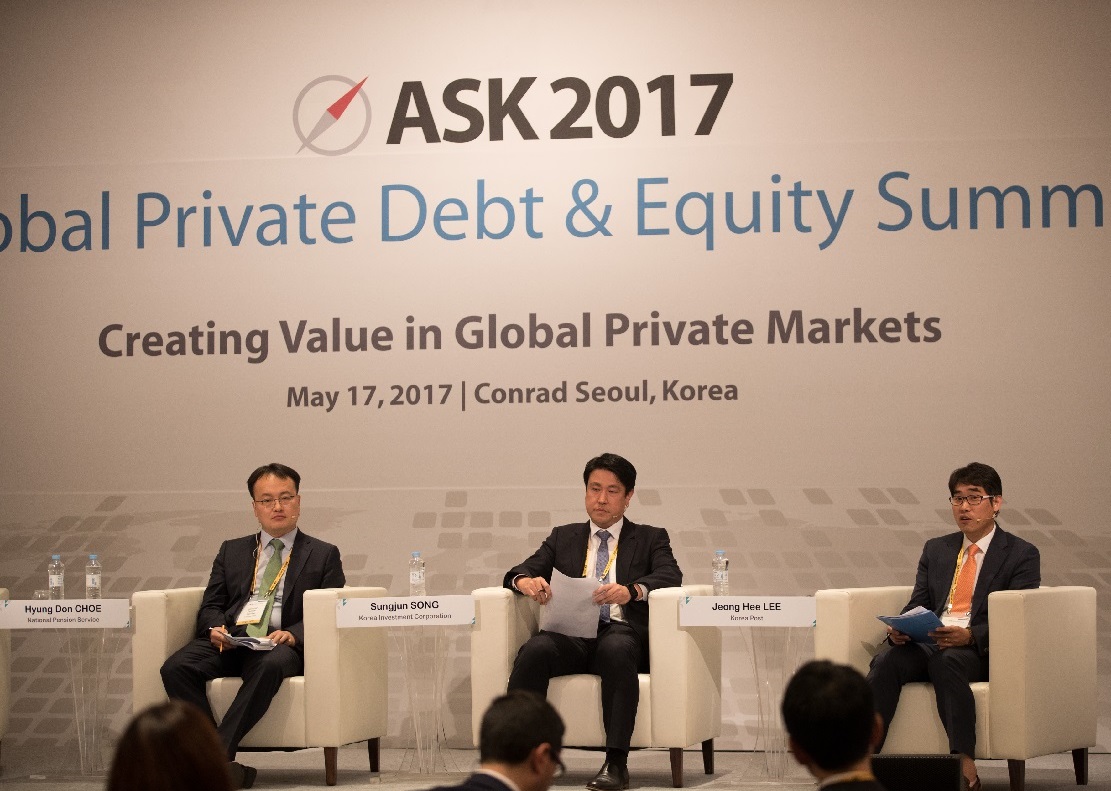[ASK 2017 SUMMIT Panel Talks] Korean LPs into mezzanine; wary of secondary
May 23, 2017 (Gmt+09:00)
LG Chem to sell water filter business to Glenwood PE for $692 million


KT&G eyes overseas M&A after rejecting activist fund's offer


Mirae Asset to be named Korea Post’s core real estate fund operator


StockX in merger talks with Naver’s online reseller Kream


Meritz backs half of ex-manager’s $210 mn hedge fund


National Pension Service (NPS), Korea Investment Corporation (KIC) and Korea Post are piling into mezzanine debt tranches in search of higher yields, but they are on the defensive about the private equity secondary market which shows signs of overheating.
Of mezzanine and distressed debt strategies, Korea Post is keen on rescue financing and will select managers running funds similar to special situation funds for PDF mandates of up to $300 million.
Korea Post’s savings arm is aiming to increase the share of private debt investment to 50% of its alternative assets from the current 38% in a long term.
The following are remarks from senior officials of NPS, KIC and Korea Post in a panel discussion during the ASK 2017 Private Debt & Equity Summit in Seoul on May 17.

▶NPS (Hyung Don Choe, head of global private equity):
“We have invested around 3 trillion won in PDFs. After beginning with direct lending and senior debt, we have moved to higher-yielding mezzanine. We are looking closely for mezzanine credit funds and co-investments. We want to do project investment in companies with a short period of time from investment to redemption and generating free cashflows. Co-investment is advantageous in terms of fees, too.”
“We achieved our goal of portfolio diversification in the past 10 years. Now we are working to raise the proportion of high-risk high-return investments. Private equity carries the highest risk and high profile. We will boost our investment (in PE) in a long term.”
“Prices in the secondary market indicate it is being overheated. We will adjust our portfolio toward selling. For new secondary investment, we use opportunity- and project-based approaches. We are trying to avoid commingled (funds).”
“In global PE funds, North American buyout funds make up around 60%; credit and mezzanine for 20%; and others for 20%. They are being operated in various forms from commingled funds and separately managed accounts (SMA) to co-investments. By region, North America accounts for 60%, followed by Europe for 25% and others for 15%. Their posted over 10% annual return in the past three years on average.”
“On venture capital investment, we see some risks there. We are interested in the North American market.”
▶KIC (Sungjun Song, director):
“Competition for private debt is intensifying. With lending restraints and expectations of interest rate rises and for creating stable income sources, we are interested in senior and secondary tranches of mid-caps. Because we have high benchmarks, we are looking closely at high-yielding mezzanine PDFs.”
“The volume and the fund size of the (PE) secondary market become larger, and competition is intensifying. We approach them for downside protection. We are looking closely at direct investment and co-investment, too.”
“Excluding hedge funds, private equity make up about half of our alternative assets. One third is invested in secondaries, private debt and venture capital. By region, the US and Europe represent 80%, followed by emerging markets for 20%. As a long-term institutional investor, we employ absolute return-pursuing strategy. We use a bottom-up investment approach.”
“On venture capital, because of plenty of capital inflows and high valuations, we are interested in early-stage venture capital investment. Considering the closed culture of the venture capital industry, we are looking at fund of fund strategy.”
▶Korea Post (Jeong Hee Lee, senior manager):
“Last year we gave mandates of senior-tranche direct lending to three firms. This year we are focusing on rescue financing among mezzanine and distressed PDFs. We will select about three management firms running funds similar to special situation funds.”
“PDFs make up around 40% of total alternatives. By region, they break down into the US, Europe and others for 6:3:1. Our target returns are 250 basis points plus domestic bond yields. We invest mainly in commingled funds.”
“We opened our first SMA last year. We will raise the proportion of SMA investment via external managers. Because we have bank-like characteristics, we will increase the proportion of private debt to 50% from 38% to create long-term income sources.”
“On venture capital, we are making effort to build networks with top-tier investment firms in Silicon Valley. We are still looking for an opportunity.”
By Donghun Lee
leedh@hankyung.com
Yeonhee Kim edited this article
-
 Real estateMirae Asset to be named Korea Post’s core real estate fund operator
Real estateMirae Asset to be named Korea Post’s core real estate fund operatorApr 29, 2025 (Gmt+09:00)
-
 Asset managementMirae Asset bets on China as Korean investors’ US focus draws concern
Asset managementMirae Asset bets on China as Korean investors’ US focus draws concernApr 27, 2025 (Gmt+09:00)
-
 Alternative investmentsMeritz backs half of ex-manager’s $210 mn hedge fund
Alternative investmentsMeritz backs half of ex-manager’s $210 mn hedge fundApr 23, 2025 (Gmt+09:00)
-
 Real estateRitz-Carlton to return to Seoul, tapped by IGIS Asset for landmark project
Real estateRitz-Carlton to return to Seoul, tapped by IGIS Asset for landmark projectApr 22, 2025 (Gmt+09:00)
-
 Real estateS.Korean gaming giant Netmarble eyes headquarters building sale
Real estateS.Korean gaming giant Netmarble eyes headquarters building saleApr 18, 2025 (Gmt+09:00)


